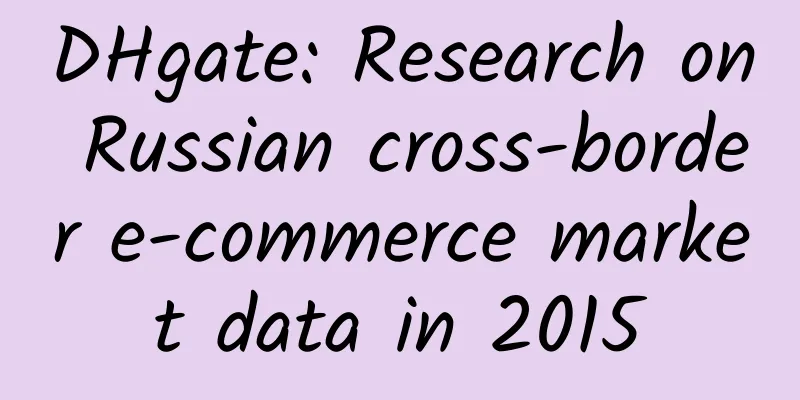DHgate: Research on Russian cross-border e-commerce market data in 2015

|
According to data insight forecasts, the total number of online shoppers in Russia will reach 40 million in 2015, which means that in 2015, at least 15 million Russians will shop at foreign e-commerce stores, a large number of whom are keen on shopping on Chinese e-commerce platforms, and by 2020, they will have formed a strong market purchasing power. So, where are the opportunities for Chinese cross-border e-commerce sellers? What are the market trends in Russia? How to solve payment and logistics problems? DHgate combines data insights with data from Russia's largest search engine, YANDEX, to unveil the Russian cross-border e-commerce market. 1. Russian Market Analysis Since AliExpress entered the Russian market in 2012, more and more people have begun to target emerging markets, and competition in Russia has become increasingly fierce. Why is the Russian market and the entire Russian-speaking market so attractive? Russian is one of the most widely spoken languages in the world, ranking sixth in terms of number of speakers. The total number of Russian speakers in the world exceeds 300 million. Due to historical reasons, there are quite a few Russian speakers in Belarus, Ukraine, Kazakhstan, and even in faraway countries such as Azerbaijan (8.3 million Russian speakers in Ukraine and 4.5 million in Kazakhstan). According to monthly data provided by the Public Opinion Foundation (FOM), by the fall of 2014, 62% of Russian adults, or 72.3 million people, used the Internet, of which 59.9 million used it every day. More and more Russian consumers are shopping across borders. According to a survey by GfK1, the share of online consumers who purchased at least once in foreign online stores in 2014 increased from 36% last year to 50%. In particular, the popularity of Chinese online stores has increased significantly. Compared with 25% in 2013, 39% of respondents shopped in Chinese online stores in 2014. From April 2013 to April 2014, Russia saw a strong increase (47%) in the time European visitors spent on the Internet - an extra 12 hours a year. In Europe, Russia is now the second most engaged country, after Turkey. The following table is a statistical data of the Russian cross-border e-shopping market in the past few years and a forecast for the next two years released by an authoritative foreign organization in 2014. In the long run, the potential of the Russian e-commerce market is far from being utilized. The market size will continue to grow, and the growth points come from the following structural factors: 1. The growing penetration of the Internet and e-commerce in the Russian region; 2. Electronic signatures and online payments become more popular; 3. The maturing of infrastructure: As transportation costs decrease, the scope of e-commerce will expand to cheaper product categories and even reach small cities and remote areas. 4. Oriented towards domestic and new international partners: As the ruble continues to depreciate, Russian consumers may buy less and less online and offline goods priced in dollars and euros, and therefore turn to domestic and countries like China that offer a wide selection of relatively cheap cross-border goods for shopping. According to data from YANDEX, Russia's largest search engine, three words frequently appear in searches related to China: "store", "goods" and "delivery". This refers to Chinese online stores, Chinese goods and delivery services. In general, 45% of search requests are related to various goods, which is more than other countries. In fact, the interest in Chinese goods and services is even higher, because in addition to search requests related to Chinese goods, there are also search requests related to Chinese mail tracking or Chinese online store translation (such as: [Taobao Chinese-Russian translator download]). 2. Demands and consumption behavior of Russian online shoppers 1) Regional development is unbalanced, with a large gap between the east and the west Russia is a highly complex market. The country is vast, spanning two continents, with significant differences in broadband penetration and IT proficiency in different regions. In some areas, local consumers are prone to indecision when shopping online, but are relatively open in other areas. Generally speaking, central urban areas account for most of the domestic e-commerce market, and the average market size in Moscow is about 10 times that of other regions. Russia is the largest country in the world. One quarter of its area is located on the west side of the Ural Mountains and belongs to Europe; three quarters of its area is located on the east side of the Ural Mountains and belongs to Asia. However, the population distribution is just the opposite. Three quarters of the population lives in Europe, while only one quarter of the population lives in Asia. Moreover, the income level of residents is much lower than that of the European part. The distribution is relatively scattered and the logistics infrastructure is backward. Nevertheless, due to their proximity to China and their economic level, residents in the eastern region have a stronger sense of identity with China and a stronger demand for Chinese products (European residents prefer European and American products). According to the Russian user's interest in foreign search reports, China ranks fourth in the foreign rankings. The monthly search volume reaches 4.1 million times - 5% of the total country-related searches. Among the Russian regions, residents in Siberia and the Far East have the strongest interest in China. In some cities bordering China, such as Chita, Chinese products have almost taken an absolute advantage in the market. From gloves to daily vegetables and fruits, almost all of them are imported from China. Every day, there are several trains and buses going to China for shopping and consumption. At the same time, the problem that cannot be ignored is that in the past few years, Chinese merchants have sold inferior and fake goods in the local area, which has greatly damaged the image of Chinese products. Establishing a reputation for high quality and low prices is extremely important to win the market in this region. This regional market is suitable for establishing border warehouses for shipment, and many logistics companies such as Russian Express have been equipped with border warehouse services. 2) Category demand is somewhat unique The two main reasons why Russian consumers shop across borders are lower prices and a wider range of goods, both of which are available from China. The main categories of Chinese goods they buy are clothing and accessories, followed by mobile phones and telecommunications peripherals. ① Product demands of Russian buyers In terms of market segments, while there are some differences in the picture from different sources due to different methodologies, the overall picture is clear. The physical goods categories saw the bulk of demand in apparel and footwear; appliances and housewares, consumer electronics and computer hardware, as well as automotive parts and children's goods. Among Chinese products, Russian users most often search for cars and motorcycles ([Chinese motorcycle 250 cubic centimeters long-distance endurance competition evaluation], [Chinese jeep]), clothing ([how to accurately choose Chinese clothing sizes], [Chinese lion pattern sweatshirts]) and various electrical appliances ([order cheap tablets in China], [Chinese sweeping robot rankings]), etc. In terms of the absolute number of searches related to "cooking", China ranks second among other countries, but the share of "cooking" related searches in other searches related to "China" is not large. //www.ulmart.ru and //www.ozon.ru/ are the leaders of the Russian e-commerce industry. Their products cover almost all categories, but they are mainly home appliances. Sellers of different categories can look at their selections of each category and summarize the characteristics of targeted selections. //www.lamoda.ru/ is a website specializing in clothing, shoes, and cosmetics. Considering the current logistics and delivery time efficiency, the products that Russians choose to buy from China have some common characteristics: differentiation and richness, or relatively obvious price advantages. When selecting clothing, shoes and hats, you can grasp their basic style and seasonal needs (it is popular in the season, and you can't sell spring clothes in winter, or winter clothes in spring), and try to be personalized; 3C and auto parts should focus on accumulating credibility, and the product description should be accurate. It is best to find a translation company to translate it into accurate Russian, and at the same time, mainly promote products that have good reviews from buyers. ②Gender and age of Russian buyers According to a research report released by Yandex and GFK in 2013, men prefer to buy goods from English websites (54%) compared to Chinese websites, while most women prefer to shop from Chinese online stores (52%). This phenomenon may be related to the categories of goods purchased. Women mostly buy clothing, accessories, children's products and household items. In the Chinese market, these low-priced goods are widely used. At the same time, men often focus on buying electronic products and auto parts. In addition, the core age group for cross-border online shopping is between 20 and 29 years old. In Russia, this age group is also the most active age group, and they have a deep understanding of international payment methods. About 40% of respondents in this age group have shopping experience on English and Chinese retail platforms. 3) Other Russian-speaking countries So far, Belarus, Kazakhstan, Kyrgyzstan and Moldova have legally granted Russian the status of "official language" or "second official language". Ukraine is also a country where Russian is widely used. Estonia, Latvia, Lithuania, Georgia, Armenia, Azerbaijan, Uzbekistan, Turkmenistan and Tajikistan also have a considerable population speaking Russian. Many workers in Russia come from these countries. Although they have not studied Russian specifically, they are all very proficient in Russian. Ukraine and Belarus are the countries with the largest market capacity among Russian-speaking countries other than Russia, followed by Kazakhstan. There are also many orders from the three Baltic countries of Lithuania, Estonia and Latvia. As an oil country, Azerbaijan also has a relatively impressive economy. It is worth noting that the current market competition in Russia is very fierce, and the markets of other Russian-speaking countries outside Russia are less concerned. The number of people in these countries who shop online from China is still relatively small, but there is a certain proportion of Class B customers, and the repeat purchase rate is much higher than that of Russia, Ukraine and Belarus. Considering the current economic development level of these countries, many regions are still relatively scarce in terms of goods, and there are still few goods that can be seen everywhere in China in the local area. Wholesalers purchase goods from large cities such as Moscow and then wholesale them to smaller retailers in the market. If they can win local small Class B buyers, sales will be greatly improved. 3. Russian logistics and customs clearance During the operation, we found that many sellers have set the setting of not shipping to Russia. Some of them may not consider the Russian market, and some of them are improper operations. Here we remind all sellers that if they want to enter the Russian market, they must first check the logistics settings of all products, and there must be no situation of not shipping. It is best to set free shipping. The services of the four major international couriers in Russia are also very different from those in Europe and the United States. Not only are the prices much higher (sellers can sample one or two products to see the prices of DHL, UPS, FEDEX, and TNT to Russia. The freight for a few kilograms in some remote cities may even be displayed as tens of thousands of dollars), but also products with electricity and magnetism cannot be mailed, and there are many customs clearance requirements. Even if the freight forwarder is very strong, it will still often encounter customs detention or returns. Therefore, unless the product is very formal, the procedures are also complete, and there is a long-term cooperation with the freight forwarder, the route is very familiar, and the product value is high, it is not recommended to use the four major couriers. In addition, parcels sent by postal parcels often encounter the problem of expired delivery, and customers have to pick up the parcels themselves after they arrive, and they cannot be delivered to the door, which is very unfavorable to the customer experience. For Class B buyers, the speed of delivery is crucial to their capital turnover and sales. Endlessly going to the post office to handle procedures and pick up parcels is not conducive to customers placing orders for a long time. Therefore, our platform has specially introduced several logistics dedicated lines, which have more controllable timeliness, and some dedicated line products also provide door-to-door delivery services. It is recommended that you set up free shipping when shipping to Russia, and give priority to the Russian special line when setting the freight template. For non-electronic small package products, it is recommended to use Ruston Russian Air. (Note: Ruston Express mail has been renamed Ruston Russian Air, Ruston Express has been renamed Ruston Commercial) Ukraine has also launched an offline delivery line. Interested sellers can check it in the seller backend. Dedicated lines for other countries will be added gradually depending on actual demand. If sellers have any questions about logistics and delivery, they can consult DHLINK's customer service, and if there are new requirements, they can also feedback to us in time. |
>>: Fanli.com: 2015 Mid-Year Cross-Border E-Commerce User Survey
Recommend
The weather is too hot and you want to "fly up to the sky" to teach the sun a lesson? Here are three ways to do it
"I want to fly up to the sky and stand shoul...
Is it safe to eat the Basa fish that costs only a few dollars a bag in the supermarket?
Have you noticed that restaurants love to use Bas...
Do you dare to challenge a cup of cockroach milk?
Key Points ★ "Cockroach milk" is not or...
Can I still eat the Chinese medicinal sea cucumber if it is moldy?
Sea cucumber is a health product with relatively ...
The efficacy and function of horse stubble cream
Horse wither paste is a kind of Chinese herbal me...
The peak of blue algae bloom is approaching, so stop adding nutrients to the water indiscriminately!
Summer is coming, and the peak period of blue alg...
"What's my zodiac sign?" There is actually a national standard for this!
Whether in daily life or during festivals, many p...
The efficacy and function of fir fruit
Do you know about fir fruit? It is a common medic...
Don't wait until you are thirsty to drink water, it will be too late! These misunderstandings about drinking water are very harmful...
Water is the source of life. It is not only an es...
These "milk tea", "coffee" and "stamps" are all new drugs! Be careful!
The seemingly ordinary "milk tea" and &...
The Self-cultivation of a "Bartender"
Let’s first look at this question: There is a cla...
The efficacy and function of Sanxueqin
Diseases require improvement through medicine. Di...
Attention, tourists! Our next stop is Lung Lobe!
These four tips to increase your lung capacity: I...
Why is it "limit salt" instead of "quit salt"?
Author: Cui Yihui, registered dietitian Reviewer:...
The efficacy of drinking water soaked with astragalus and rose
Nowadays, many people like to drink herbal tea. T...









